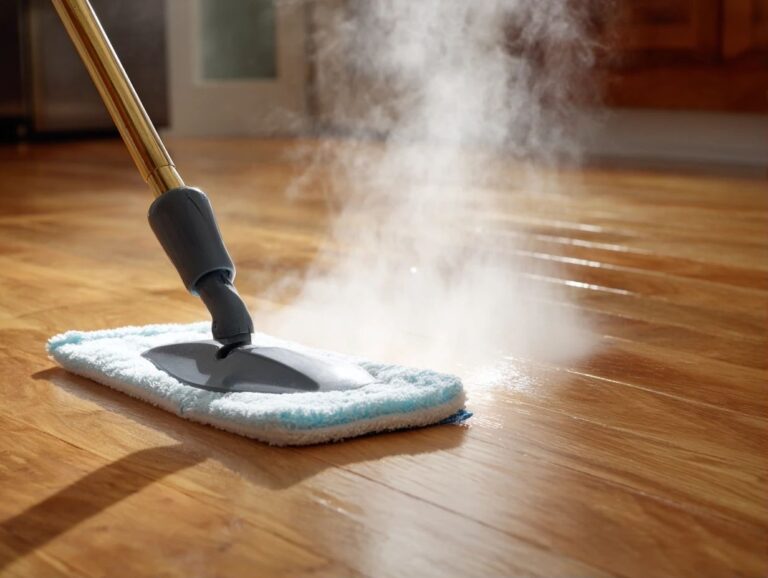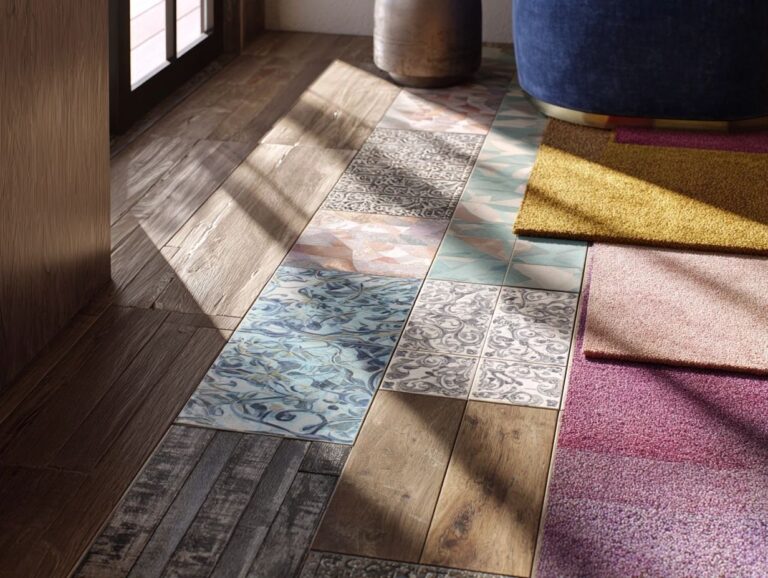Flooring for Wheelchair Accessibility – ADA Guidelines
Contents
- Introduction to ADA Guidelines for Flooring
- Understanding Wheelchair Accessibility
- Wheelchair Accessible Flooring Effectiveness Study
- Types of Flooring Materials
- ADA Guidelines for Flooring
- Flooring Design Considerations
- Installation Best Practices
- Case Studies and Examples
- Frequently Asked Questions
- 1. What type of flooring is recommended for wheelchair accessibility according to ADA guidelines?
- 2. Are there any specific requirements for the levelness of flooring in regards to wheelchair accessibility?
- 3. Is there a recommended thickness for flooring in order to meet ADA guidelines for wheelchair accessibility?
- 4. Can hardwood flooring be used in areas that require wheelchair accessibility?
- 5. Are there any flooring materials that are not recommended for wheelchair accessibility according to ADA guidelines?
- 6. Are there any additional considerations to keep in mind when selecting flooring for wheelchair accessibility?
Introduction to ADA Guidelines for Flooring
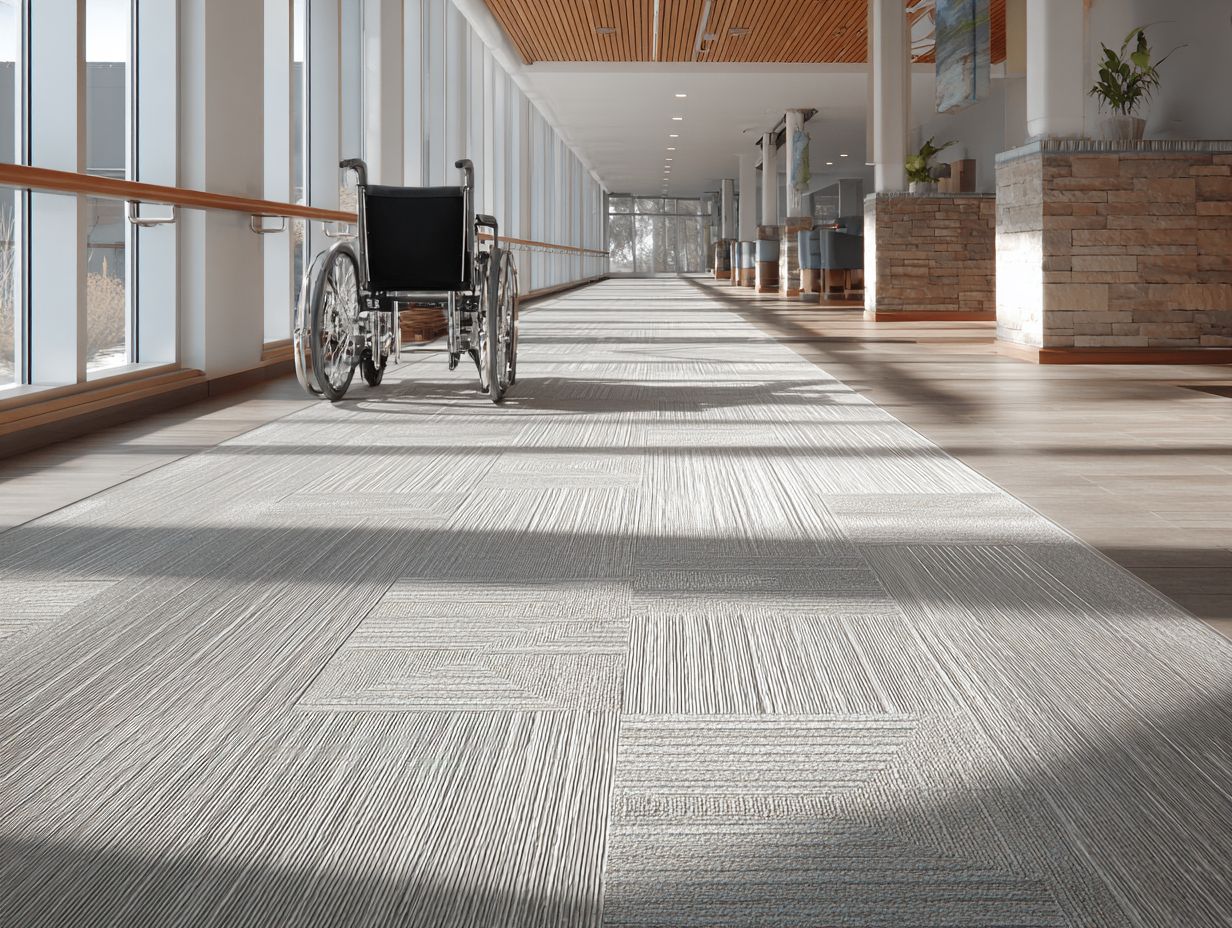
Key Takeaways:
Importance of Accessibility
Flooring needs to be accessible because more than 7 million Americans use wheelchairs and other mobility aids, impacting their daily lives.
Flooring designs that are easy to use have gentle shifts between surfaces, non-slip textures, and minimal height variations, which help people with mobility challenges get around more easily.
For instance, using vinyl or cork flooring can provide a slip-resistant finish, while low-pile carpets help wheelchairs roll more smoothly.
Public accommodations, like restaurants and stores, must adhere to ADA standards, which stipulate that entrances should feature level surfaces and ramps.
By addressing these points, businesses can make their environment friendly for all and comply with legal rules.
Overview of the ADA
The Americans with Disabilities Act (ADA) has rules to make sure public areas are open to everyone, which includes guidelines for flooring materials.
For both commercial and residential units, the ADA specifies flooring must be slip-resistant, even in wet conditions, to prevent falls.
Surface textures should facilitate wheelchair mobility. For example, using materials like textured vinyl or low-pile carpet makes it easier for people to move around and find their way.
Pathways must be at least 36 inches wide to allow enough room for people to move. Regular maintenance is important. Surfaces must be kept clean and clear of obstacles to meet ADA standards properly.
Understanding Wheelchair Accessibility
Creating accessible areas for wheelchair users means choosing flooring that lets people move easily with wheelchairs and other mobility equipment.
Wheelchair Accessible Flooring Effectiveness Study
Wheelchair Accessible Flooring Effectiveness Study
Flooring Impact on Performance: Rolling Resistance
Flooring Impact on Performance: Sprint Performance
Flooring Impact on Performance: Fatigue Index Across Flooring
The Wheelchair Accessible Flooring Effectiveness Study evaluates the performance of various flooring types in terms of rolling resistance, sprint performance, and fatigue index for wheelchair users. This analysis is important for finding the best flooring options that make movement easier and require less effort for people using wheelchairs, thereby making their lives better.
Flooring Impact on Performance encompasses several critical metrics. Rolling Resistance is a key factor influencing the ease of movement. The data indicates that wood parquet has a baseline resistance value of 3.98. In comparison, the resistance increases by 60% with BAL flooring and by 106% with GER-TX flooring. The increases mean that wood parquet is much easier to move a wheelchair over, making it a great option for reducing the effort needed.
- Sprint Performance: On wood parquet (WP), wheelchair users experience a 7.42 reduction in sprint time and can achieve a maximum velocity of 4.22. This improvement shows that WP allows for faster movement, which is useful when quick travel is needed.
- Fatigue Index Across Flooring: Assessing the fatigue index reveals that WP has the lowest fatigue index of 5.9, followed by GER-TX at 7.5, and BAL at 9.8. Lower fatigue indices on WP suggest that users expend less energy over time, thus reducing exhaustion and potentially extending the duration of activity.
In summary, the study findings advocate for wood parquet as the superior flooring option for wheelchair users, given its lower rolling resistance, improved sprint performance, and reduced fatigue index. Using WP can greatly improve movement and ease, making it a popular option for creating accessible areas.
Defining Wheelchair Accessibility
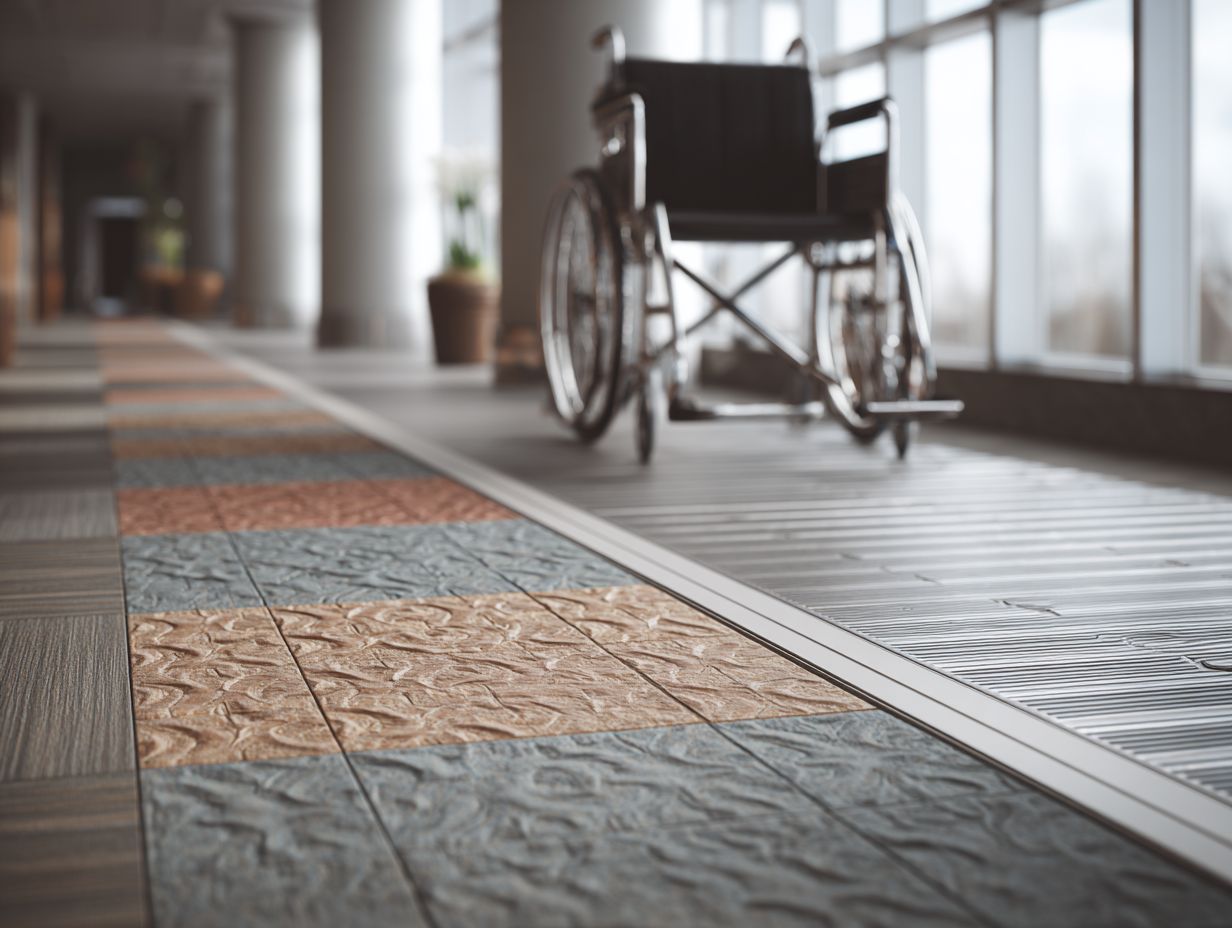
Wheelchair accessibility is defined by the ability to move freely without barriers, which is directly influenced by flooring choices and conditions.
To make sure a place can be used by everyone, pay attention to some important details.
- Flooring should be firm, level, and non-slip; materials like polished concrete or low-pile carpeting work well.
- Consider the minimum clear width for doorways, which should be at least 32 inches to accommodate most wheelchairs.
- Smooth changes between flooring styles are important; ramps should have no more than a 1:12 slope ratio.
- Make sure there is at least 60 inches of open space so users can turn and move around easily.
Common Challenges Faced
Common challenges in achieving wheelchair accessibility include uneven surfaces, inadequate transitions, and improper material choices that hinder movement.
To solve these problems, make sure there are smooth changes between surfaces by using ramps with a slope ratio that does not exceed 1:12.
Select materials with high friction coefficients, such as textured concrete or rubber, to prevent slips. Regular maintenance is important. Look at the paths every month to find any cracks or things that might get in the way.
Ask users for feedback to find out which areas need work, improving how the space looks and works overall.
Types of Flooring Materials
Picking the appropriate flooring is important for meeting ADA rules and offering long-lasting and safe surfaces.
Hard Surface Flooring
Vinyl plank and ceramic tile floors are durable and slip-resistant, making them ideal for high-traffic areas.
For instance, Shaw Endura Anvil vinyl plank is designed for both aesthetic appeal and practicality, meeting ADA standards with a slip resistance rating of over 0.5.
Similarly, ceramic tiles, such as Daltile’s Revo Tile, boast a rugged surface suitable for commercial spaces while resisting moisture and stains.
When choosing flooring, think about your surroundings; both choices can improve safety and last longer. Incorporating area rugs can further reduce slip risks in areas prone to moisture without compromising style.
Carpet and Soft Flooring
Low-pile carpet can provide comfort while still meeting ADA standards for accessibility, particularly in residential units.
For wheelchair users, carpets that are no thicker than 1/4 inch are best, as they make moving around easier than thicker carpets.
Looped or Berber styles can pose problems due to snagging, so consider cut-pile options that offer both softness and mobility. Products like SmartStrand or SoftSpring, known for their durability and soft fibers, are excellent choices.
Make sure the carpet has a strong base to keep it in place and lower the chance of tripping, making it safer for everyone.
Specialized Flooring Options
Special flooring options, like rubber flooring, improve safety by offering better impact absorption and slip resistance for ground-floor apartments.
These features are especially useful in busy places like entrance halls, playrooms, or gyms where falls might happen more often.
When choosing rubber flooring, consider options like interlocking tiles for easy installation and maintenance, or rolled sheets for larger spaces.
Look for brands such as EcoFlex, which offers durability and eco-friendly materials, or Rubber-Cal, known for customizable designs.
Make sure the flooring complies with ADA rules to guarantee it is safe and accessible for all residents.
ADA Guidelines for Flooring
The ADA guidelines set clear rules for flooring to make sure everyone, especially those in public areas, can move around safely and easily.
Surface Characteristics
Surface traits like texture and slip resistance, measured by the Coefficient of Friction, are important for preventing accidents in areas accessible to wheelchairs.
To meet ADA standards, check materials such as rubber flooring. It typically has a high Coefficient of Friction (0.8 or higher), making it very safe.
Textured surfaces like brick or matte tile finishes can improve grip. Regularly cleaning to get rid of debris and moisture is important; using items like floor mats and cleaning products made for high-traction can greatly reduce slipping risks.
When selecting materials, consider both function and aesthetic to maintain an inviting environment.
Slopes and Ramps
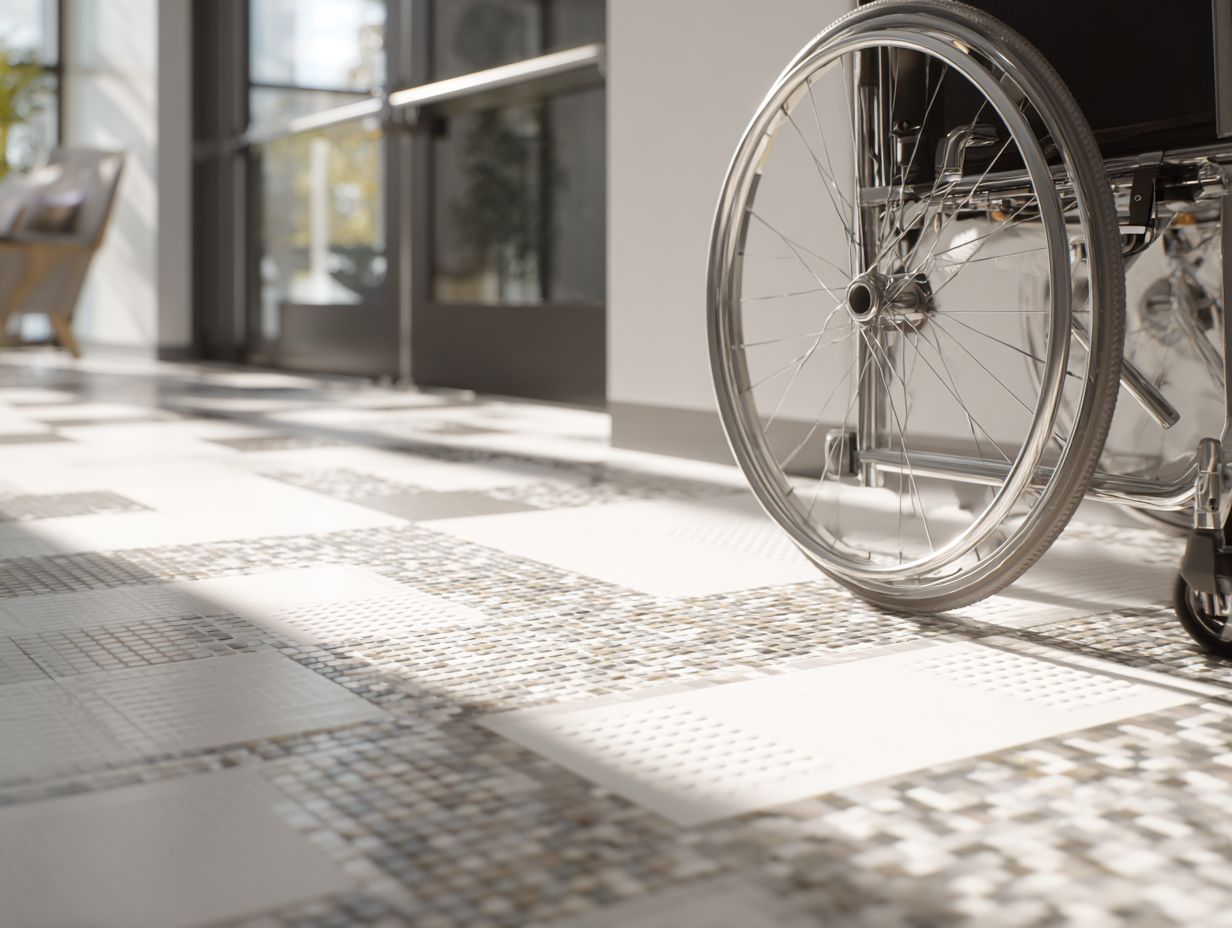
The ADA guidelines state that ramps must have a certain slope for wheelchair users’ safety and accessibility. The usual slope is 1 foot of rise for every 12 feet of ramp length.
For each inch the ramp rises, it needs to be twelve inches long. Ramps must have a minimum width of 36 inches and include handrails if the rise exceeds 6 inches.
Building ramps with materials that have good grip, such as concrete or treated wood, is important to avoid accidents. Always check the most recent ADA standards and local building rules to make sure your design supports safety and access for all people.
Transitions Between Different Flooring Types
Proper transitions between different flooring types are essential to avoid hazards for wheelchair users, adhering to ADA standards for seamless surface changes.
For easy movement that follows ADA rules, use rubber strips or sloped transitions at thresholds.
For example, a 1-inch rubber transition strip can effectively bridge the gap between a tile and carpet, minimizing tripping hazards. Make sure the change in height is no more than 1/2 inch.
Installation requires using construction adhesive and ensuring that all edges are securely fastened. Check these areas often for damage, as keeping surfaces flat is important for safety.
Flooring Design Considerations
When planning flooring, think about how it looks and works. Make sure it meets accessibility rules and improves safety.
Color Contrast for Visibility
Using color contrast in flooring design improves visibility for people with visual impairments, meeting ADA standards for accessible spaces.
To achieve effective color contrast, consider the following methods:
- Use light and dark shades within the same color family to create depth;
- Use patterned tiles to clearly mark pathways;
- Use different edge strips to show changes between flooring surfaces.
For instance, using a dark tile against a light wall can guide individuals through public spaces like airports or hospitals. Make sure your choices follow the ADA rule of having at least a 70% contrast ratio. This greatly helps with finding your way and improves safety.
Texture and Grip
The texture and grip of flooring materials are very important for preventing slips and falls, especially in places with a lot of foot traffic and moisture.
To improve safety and comply with ADA rules for preventing slips, think about using materials like textured vinyl, micro-slip ceramic tiles, or rubber flooring.
Textured vinyl offers a cost-effective solution with raised patterns, providing substantial grip without sacrificing style. Micro-slip ceramic tiles are durable and attractive, making them a suitable option for homes and commercial spaces.
Meanwhile, rubber flooring, commonly used in gyms and healthcare facilities, effectively reduces slip hazards while offering cushioning. Always verify the friction ratings to meet safety rules.
Installation Best Practices
It is important to follow recommended methods during installation so that flooring adheres to ADA standards and works well in areas designed for accessibility.
Ensuring Level Surfaces
It is important to keep surfaces level during installation to comply with ADA rules, which helps wheelchair users move around more easily.
To make sure the surface is flat, use a bubble level or laser level to check it while installing and afterward. A four-foot level is suitable for checking straightness in small areas, while a laser level is effective for ensuring things are straight over larger distances.
Materials like shims can help raise lower sections, while self-leveling compound is ideal for filling depressions.
Checking frequently during installation, every few feet, helps spot problems early and make sure everything meets accessibility standards.
Maintenance and Upkeep
Regular maintenance is essential to uphold ADA compliance and extend the lifespan of flooring materials, particularly in high-traffic areas.
To maintain ADA compliance, establish a monthly inspection schedule focusing on the following:
- Check for uneven surfaces which could pose tripping hazards;
- Make sure paths are clear of any obstacles;
- Inspect flooring for signs of wear that might compromise accessibility.
Quarterly deep cleaning can prevent build-up that may affect slip resistance. Implement tools like a floor maintenance checklist or mobile app to document inspections and repairs, ensuring nothing is overlooked. These proactive steps improve safety and greatly extend the life of your flooring materials.
Case Studies and Examples
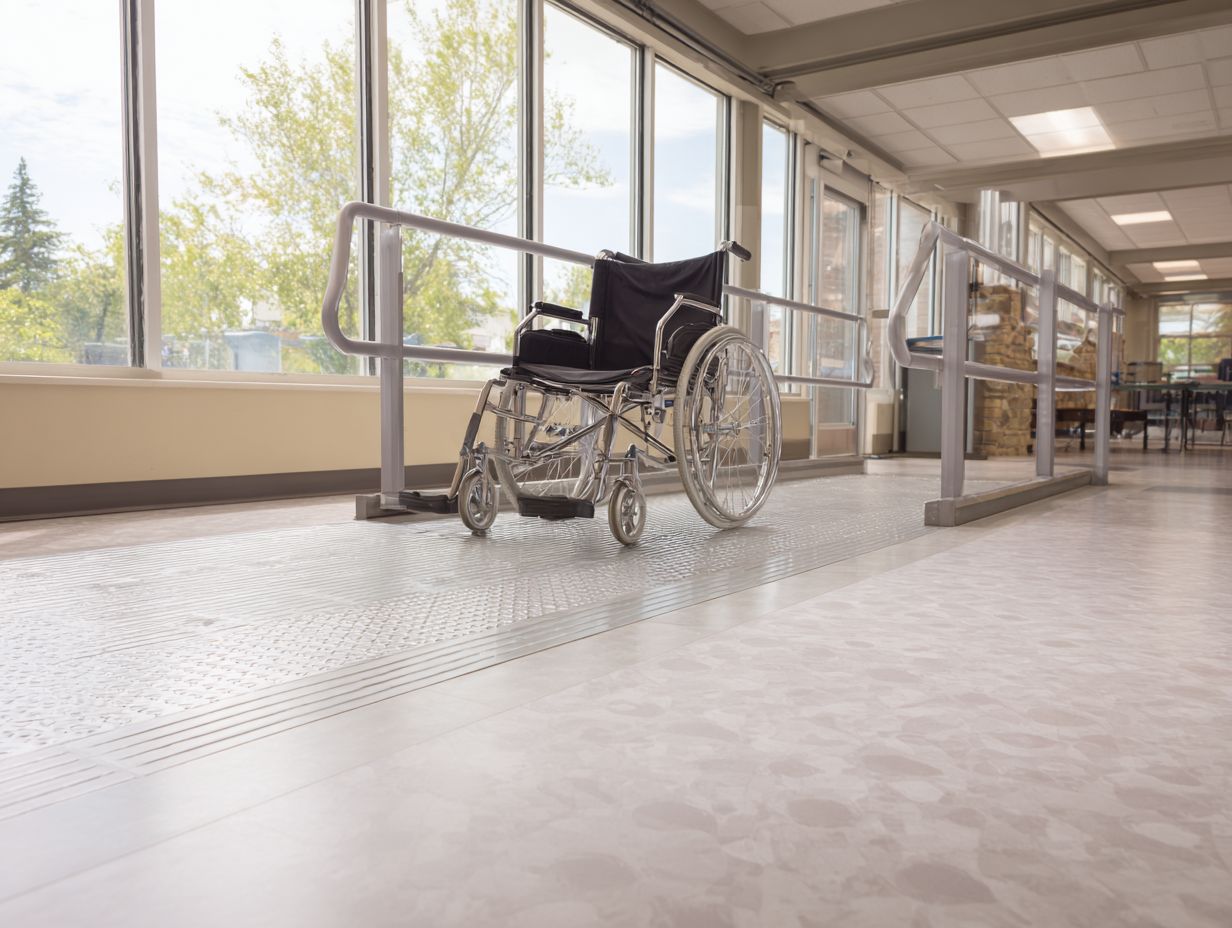
Examples from actual projects show effective methods and frequent mistakes when meeting ADA standards in flooring work across different areas.
Successful ADA Compliant Flooring Projects
Case studies of successful ADA compliant flooring projects demonstrate the practical application of guidelines and their impact on accessibility.
For instance, the San Francisco International Airport installed slip-resistant vinyl flooring in high-traffic areas, ensuring safety for all users.
A healthcare facility in Nashville installed rubber flooring, providing better traction and reducing noise, making the environment more comfortable for patients.
Both projects prioritized color contrast to aid those with visual impairments, reinforcing the importance of thoughtful design.
By choosing these materials, organizations can make spaces that meet regulations and are pleasant and useful for all.
Lessons Learned from Non-compliance
Looking at cases where standards are not met provides important information about expensive errors that can happen when putting in and planning floors.
For instance, a high-end hotel in Chicago faced a major lawsuit due to improper installation of luxury vinyl planks, resulting in water damage. They created a complete training program for their employees and revised their installation instructions, reducing possible risks down the road.
Similarly, a residential project in California encountered issues with non-compliant underlayment, leading to squeaky floors and repair costs. After talking with legal experts, the homeowner hired a certified flooring inspector to make sure all local regulations were followed.
These cases highlight the importance of adhering to industry standards and investing in ongoing education to mitigate risks.
Future Trends in Accessible Flooring
Upcoming flooring trends will probably center on improved materials that blend looks with meeting ADA requirements, focusing on environmentally friendly choices.
For instance, luxury vinyl tile (LVT) is gaining popularity for its durability and wide range of design options, positioned as an alternative to hardwood.
Rubber flooring is emerging due to its slip resistance and superior cushioning, ideal for high-traffic areas.
Brands like Karndean are leading in stylish LVT designs that are also eco-conscious. Consumers are also gravitating towards natural materials such as cork and bamboo, which provide both comfort and sustainable benefits.
This shift reflects a broader trend toward inclusivity and environmental responsibility in home design.
Frequently Asked Questions
1. What type of flooring is recommended for wheelchair accessibility according to ADA guidelines?
According to ADA guidelines, the most recommended type of flooring for wheelchair accessibility is a smooth, firm and slip-resistant material such as vinyl, linoleum, or low-pile carpet.
2. Are there any specific requirements for the levelness of flooring in regards to wheelchair accessibility?
Yes, according to ADA guidelines, floors should not slope more than 1:48 (2.08%). The height can increase by up to 1/4 inch (6.4 mm) for every 2 feet (610 mm) traveled by a wheelchair.
3. Is there a recommended thickness for flooring in order to meet ADA guidelines for wheelchair accessibility?
There is no specific requirement for thickness, but it is recommended to choose a flooring material that is at least 1/8 inch (3.2 mm) thick in order to withstand the weight and movement of a wheelchair.
4. Can hardwood flooring be used in areas that require wheelchair accessibility?
Yes, hardwood flooring can be used in areas that require wheelchair accessibility, as long as it is properly installed to meet the levelness and slip-resistance requirements of ADA guidelines.
5. Are there any flooring materials that are not recommended for wheelchair accessibility according to ADA guidelines?
Avoid using high-pile carpet, glossy or polished surfaces, and rubber flooring with a raised pattern, as these materials may hinder wheelchair movement and pose a safety hazard for wheelchair users.
6. Are there any additional considerations to keep in mind when selecting flooring for wheelchair accessibility?
In addition to meeting ADA guidelines, it is important to choose a flooring material that is easy to clean and maintain, as well as durable enough to withstand the wear and tear of wheelchair use. It is also recommended to select a flooring material with a low VOC (volatile organic compound) content for better indoor air quality.

